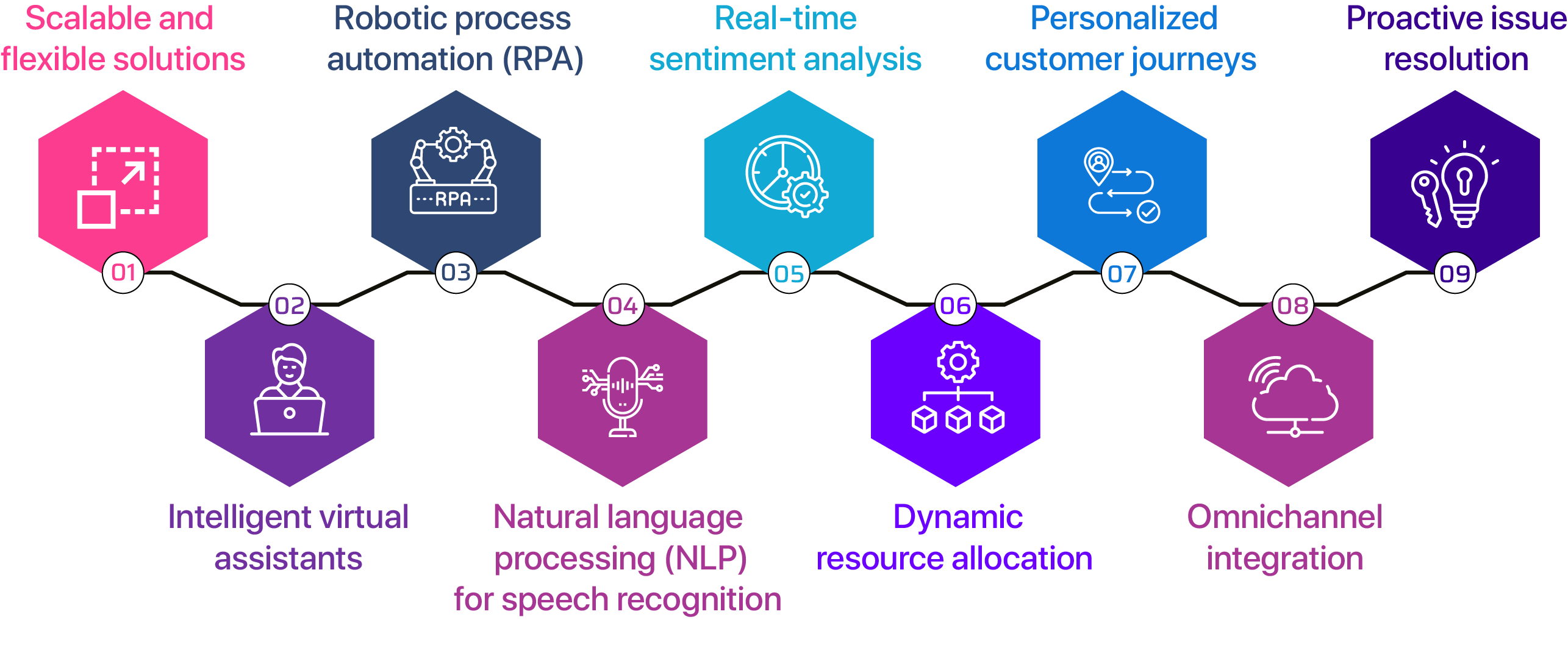
Listen to this blog
Contact centers are evolving from traditional customer service hubs into dynamic engines of customer experience management.
It's 2025, and the contact center has evolved. To thrive, businesses must meet sky-high customer expectations for speed, personalization, and quality—all while streamlining costs. AI isn't optional; it's the key. In this article, we'll dive into nine actionable strategies to leverage AI and automation, transforming your contact center into a powerhouse of performance and agility.


Automation enables contact centers to be scalable and flexible, allowing them to easily adapt to fluctuating customer demand and business growth. Whether it’s a Black Friday rush or a quiet Tuesday morning, automation ensures seamless performance without stretching resources too thin.

AI-powered chatbots and virtual assistants can handle high volumes of repetitive queries, such as account balances or order tracking, with speed and precision. These systems can work 24/7, offering instant resolutions and escalating complex issues to agents when necessary. This reduces wait times and enhances service availability.

Automating repetitive backend tasks, such as updating customer records, processing refunds, or generating reports, helps eliminate errors and saves time. This reduces administrative work, and frees up agents to focus on what truly matters—building meaningful customer connections.

NLP-powered tools transcribe and analyze voice calls in real-time, capturing key insights such as customer intent or concerns. This empowers agents with deeper insights to address issues more effectively while equipping managers with data-driven coaching tools.

Sentiment analysis tools evaluate customer emotions during interactions by analyzing tone, language, or text. Agents can then adjust their approach on the fly—soothing frustrations or amplifying positive moments, creating more meaningful interactions.

AI-driven workforce management tools use predictive analytics to optimize agent schedules and resource allocation. By analyzing call volumes and patterns, these systems can predict and ensure sufficient coverage during peak hours while avoiding overstaffing during quieter periods.

Automation can personalize customer interactions by analyzing past behaviors, purchase history, and preferences. Agents armed with these insights can make tailored recommendations, making customers feel truly valued—not just another ticket number.

Customer data is centralized by AI algorithms across multiple channels, including phone conversations, chat, email, and social media. This enables agent to access the complete context of a customer's interactions on any platform resulting in a smooth and uniform experience for the customer.

In order to spot possible issues like billing irregularities or expiring subscriptions, AI systems can keep an eye on consumer accounts and interactions. Automated alerts or personalized outreach resolve issues before they escalate, reinforcing customer trust.
Picture this: It’s Black Friday, and a major retailer’s contact center is bracing for an avalanche of customer inquiries. AI chat-bots tackle thousands of order inquiries instantly, NLP tools flag a surge in delivery concerns, and sentiment analysis pinpoint frustrated customers for priority resolution. Predictive staffing ensured agents are ready—no long waits, no service meltdowns. By the end of the day, the retailer doesn’t just survive the chaos—it delivers a seamless, stress-free customer experience, turning potential frustration into brand loyalty. This isn’t just a one-day victory—it’s the future of business. In 2025, automation is the key to speed, efficiency, and scalability. It slashes inefficiencies, accelerates decision-making, and ensures businesses can grow without skyrocketing costs. From optimizing staffing to enhancing financial accuracy and fine-tuning supply chains, automation is the competitive edge. Companies that ignore it risk slower service, higher costs, and losing customers to more agile rivals. |
Conclusion
To stay ahead, contact centers must deliver faster, smarter, and more personalized service. AI-driven solutions—like sentiment analysis, virtual assistants, and predictive analytics—empower agents to anticipate issues, streamline workflows, and enhance customer experiences. The payoff? Efficiency, trust, and loyalty.
To stay competitive in a rapidly changing market and turn contact centers into dynamic centers of customer engagement, it is imperative that these solutions be adopted.




